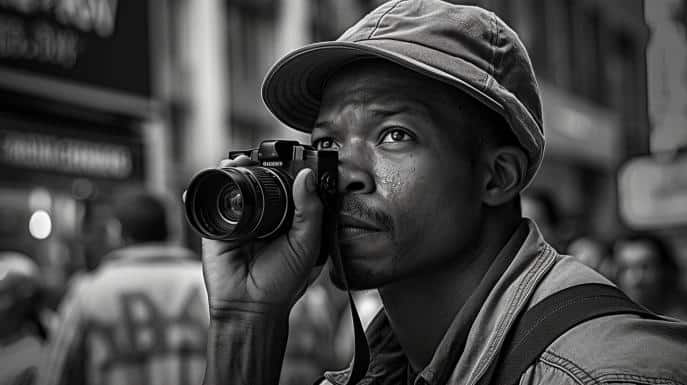Nas entrelinhas de cada aventura, há imagens à espera de serem capturadas, narrativas visuais que contam histórias de terras exploradas e momentos vividos. A arte de registrar tais cenas é uma dança harmoniosa entre o fotógrafo e seu equipamento. No artigo “Dicas de Fotografia de Viagem: Equipamentos”, emergimos na preparação essencial dos seus instrumentos de captura. Explorando as melhores configurações de câmera para cada destino, o guia indispensável de equipamentos para o mochileiro fotógrafo e métodos seguros para proteger seu valioso companheiro de viagem, você estará pronto para transformar experiências em legados visuais eternos.
Como preparar seu equipamento para capturar as melhores imagens em suas viagens?
As melhores configurações de câmera para viagem variam conforme o destino e o clima, mas em geral, um modo versátil é priorizar uma abertura f/8 para garantir nitidez e profundidade de campo. Para equipamentos fotográficos de mochileiros, escolha câmeras DSLR ou mirrorless leves, lentes com ampla faixa de zoom e estabilização de imagem. Para a segurança dos equipamentos, utilize bolsas almofadadas antichoque e nunca deixe seus itens sem vigilância. Seguindo um guia de equipamentos fotográficos essenciais, priorize a portabilidade e a versatilidade, incluindo itens como uma lente prime rápida para baixa luminosidade e uma zoom para flexibilidade.
Como aproveitar ao máximo a composição e a luz natural em suas fotos de viagem?
Quais técnicas de composição podem transformar suas fotos de viagem? A regra dos terços é a técnica fundamental. Ela consiste em dividir a imagem com duas linhas horizontais e duas verticais, posicionando elementos importantes nos pontos de interseção ou ao longo das linhas para criar uma composição equilibrada e atraente.
Luz natural versus flash: O que é melhor para fotografias em viagem? Prefira a luz natural, pois produz imagens mais suaves e naturais, especialmente durante o período conhecido como ‘hora dourada’.
Como e por que capturar a mágica da ‘hora dourada’ em suas fotos? A ‘hora dourada’ oferece iluminação suave e tons dourados, ideal para captar a beleza dos locais com uma atmosfera quente e acolhedora. Saiba mais sobre a aproveitar a luz natural em suas fotografias acessando este guia completo.
Quais são as melhores práticas para capturar a essência cultural e a beleza das paisagens em suas viagens?
Ao fotografar culturas locais, respeite os costumes e procure por retratos expressivos que comuniquem uma história. Para paisagens naturais, empregue estratégias que valorizem a vastidão e a beleza do local. E, ao compor retratos durante suas viagens, foque em capturar a autenticidade do momento e a singularidade do retratado. Utilizar espaços negativos e dar atenção aos detalhes também pode destacar a narrativa da imagem, tornando-a mais envolvente e reveladora da cultura local. Ao mesmo tempo, lembre-se de se aventurar além dos pontos turísticos para encontrar cenas únicas e genuínas, ampliando sua habilidade para capturando culturas locais em fotos, aprimorando suas dicas para fotografar paisagens naturais, e refinando a composição de retratos em viagens.
Como editar, armazenar e compartilhar suas fotos de viagem para preservar e mostrar suas experiências?
A edição de fotos de viagem é um passo crítico para realçar a beleza e o impacto das suas imagens. Utilize programas como Adobe Lightroom para aprimorar cores e contrastes. Para armazenamento e backup de fotos em viagem, soluções como discos rígidos externos e serviços de nuvem são essenciais. Ao compartilhar fotos de viagem online, plataformas como Instagram e Flickr permitem não apenas preservar, mas também exibir suas aventuras ao mundo.
Ao longo deste artigo, exploramos as nuances da fotografia em viagens, desde ajustes de câmera ideais para diferentes cenários até o armazenamento seguro de suas preciosidades visuais. Abordamos técnicas de composição e a captura da luz natural, bem como práticas respeitosas e criativas para fotografar culturas e paisagens. Por fim, discutimos a importância de editar, armazenar e partilhar suas experiências visuais. Cada imagem conta uma história, e cada configuração, uma decisão consciente, contribui para a narrativa de suas aventuras. Que as reflexões e estratégias partilhadas aqui sirvam de inspiração para que suas próximas viagens sejam tão ricas visualmente quanto em suas vivências.
FAQ
Q: Quais configurações de câmera são recomendadas para fotografar em viagens?
A: Para garantir nitidez e profundidade de campo em fotografias de viagem, priorize um diafragma com abertura f/8. Escolha equipamentos leves como câmeras DSLR ou mirrorless, lentes com ampla faixa de zoom e estabilização de imagem, sempre protegidos em bolsas almofadadas antichoque.
Q: Como posso melhorar a composição das minhas fotos de viagem utilizando a luz natural?
A: Para aprimorar a composição das suas fotos de viagem, utilize a regra dos terços e prefira a luz natural. Aproveite especialmente a ‘hora dourada’ para capturar imagens com iluminação suave e tons dourados, resultando em fotos com atmosfera quente e acolhedora.
Q: Qual é a forma mais respeitosa de fotografar pessoas e culturas locais durante as viagens?
A: Ao fotografar culturas locais, é importante respeitar os costumes e buscar retratos expressivos que contem uma história. Dê atenção especial aos detalhes e utilize espaços negativos para realçar a narrativa cultural através das suas imagens.
Q: Como devo editar e armazenar minhas fotos de viagem para preservá-las eficientemente?
A: Utilize programas de edição como o Adobe Lightroom para realçar as cores e contrastes das suas fotos de viagem. Para armazenamento seguro e backup, opte por discos rígidos externos e serviços de nuvem. Compartilhe suas experiências online em plataformas como Instagram e Flickr para mostrar suas aventuras ao mundo.



